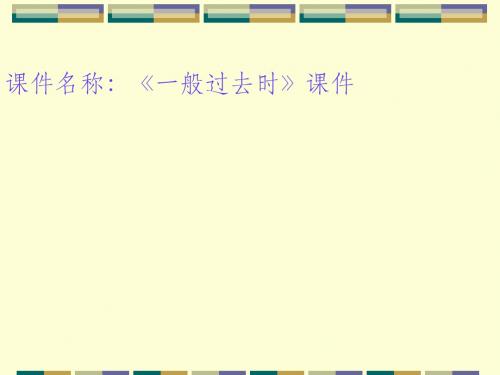八年级英语一般过去时态PPT优秀课件
合集下载
一般过去时(7张PPT)初中英语专项复习课件

易错点:
稿定PPT
(1)表示一系列的动作,尽管有先后,都稿用定一PP般T过,去海时量,素最材后持两续个动词之间用and连结。 He opened the door, rushed out and then disa更 总pp新 有ea, 一red上 款. 他千 适打款 合开模 你门板,选冲择了出去,然后就消失了。 (2)注意在语境中理解"我刚才/原来还不……"。
感谢观看
一般过去时 初中英语专项复习
一般过去时 构成:一般过去时用动词的过去式构成,其规则动词变化方法如下表所示:的状态。
情况 一般情况 以不发音的字母e结尾
以辅音字母 +y结尾
结尾只有一个辅音字母的重 读闭音节
构成方法
例词
加-ed
wash→washed help→helped
稿加定-PdPT
hope→hoped like→liked
一般过去时 (5)一般过去时有时可以表示现在,多与 want, hope, wonder, think, intend 等动词连用,使语气更委婉 。
I wondered if you could help me. 不知你能不能帮我一下。 有时用一般过去时也是时态一致的需要。 I didn’t know you were here. 我不知道你在这里。
He was here just now. 他刚才还在这里。 What did you do yesterday? 你昨天做了什么事?
(2)在过去一段时间内的经常性或习惯性稿动定作PP。T 稿定PPT,海量素材持续
We often played together when we were child更re新n.,我上们千小款时模候板常选在择一起玩。 总有一款适合你
八年级英语语法讲解-一般过去时精选教学PPT课件

Infinitive am is are begin break bring build buy can
不规则动词表
Past tense was were begun broke brought built bought could
Infinitive catch come do draw drink drive eat fall
或许,只有王林,只有他自己才知道,这个没有答案的答案吧。 这是耳根第一本真正意义上完结的作品,也是第一本仙侠,我总觉得,仙侠小说是没有结局的,我不喜欢写王林成为了宇宙苍穹第一人诸如此类的笑话。
我想写的是一个有血有肉的人,一个为了心中的逆,去一路逆天而走的男人。 修仙,没有尽头,所以我写了还有第四步,第五步,第六步,或许,还有更多,那是一条漫长的道路。 这正是代表了人的追求与执着,代表了一种理想的攀升与遥望,如前进的脚步,永生不会停止,会一直走下去。 仙逆,只是王林一生的一部分,是最早的一部分,在此后,他还会有更多的人生,只不过这部分人生,不是在书里体现,而是在我们的想象中畅游。
passed cooked 2、元浊 /d/ ,即 ed 在元音,浊辅音后面念 /d/ ,
例:borrowed enjoyed called moved
3、/t/ /d/ 之后念 /id/ , 即 ed 在 /t/ /d/ 音后面念 /id/ 例:wanted shouted needed counted
Past tense caught came did drew drank drove ate fell
用法 1、表示过去某个时间发生的动作或存在的状态。
He was here yesterday. I got up at six thirty yesterday morning. My father was at work yesterday afternoon. Did you have a good time last summer?
初中英语语法 八大时态之一般过去时课件

They live in Shanghai . They lived in Shanghai last year.
I study in Beijing. I studied in Beijing .
she stops. she stopped.
I go to school by bike every day. I went to school by bike yesterday.
以e结尾的,直接在词尾加d dance - danced 辅音加y结尾,变y为i加ed study - studied 重读闭音节结尾,双写词尾字母加 ed stop - stopped 3.不规则变化: 没有变化 cut -cut put-put come-come hit-hit let-let 特殊情况 have/has—had, go---went, eat---ate, say—said
1
last year
时间
last week
标志 2 last weekend
The day before
3 。。。。。。
一般过去时
动词的变化
一般过去时-含有be动词的
• She is in Beijing.
She was in Beijing .
• I am a student.
I was a student.
read — read
write — wrote say — said
play — played
learn — learned buy — bought cry — cried
study — studied swim — swam walk — walked
一般过去时主要动词的变化:
I study in Beijing. I studied in Beijing .
she stops. she stopped.
I go to school by bike every day. I went to school by bike yesterday.
以e结尾的,直接在词尾加d dance - danced 辅音加y结尾,变y为i加ed study - studied 重读闭音节结尾,双写词尾字母加 ed stop - stopped 3.不规则变化: 没有变化 cut -cut put-put come-come hit-hit let-let 特殊情况 have/has—had, go---went, eat---ate, say—said
1
last year
时间
last week
标志 2 last weekend
The day before
3 。。。。。。
一般过去时
动词的变化
一般过去时-含有be动词的
• She is in Beijing.
She was in Beijing .
• I am a student.
I was a student.
read — read
write — wrote say — said
play — played
learn — learned buy — bought cry — cried
study — studied swim — swam walk — walked
一般过去时主要动词的变化:
英语语法——一般过去时课件(共44张PPT)

例:Wendy was in the seventh grade last year. Was Wendy in the seventh grade last year?
肯否回答:
一般疑问句: Be动词(was/were)+主语+其他+?
肯定回答:Yes , 主语+ was/were. 否定回答:No , 主语+ wasn’t/weren’t . --- Was he at home yesterday ? ---他昨天在家吗? --- Yes , he was .是的,他在 --- No , he wasn’t . 不,他不在。
study — studied
carry— carried
5.不规则变化. (见不规则动词表P97)
be动词 的一般过去时
Please look at the sentences
我今年12岁. I _a_m_ 12 years old this year.
我去年11岁. I _w_a_s_ 11 years old last year.
实意动词的一般 过去时句子结构
每天,早餐我吃鸡蛋和牛奶。 I _h_av_e_ eggs and milk for breakfast every morning.
昨天,早餐我吃面条。
I _h_a_d_ noodles for breakfast yesterday morning.
他每天都吃水果。 He _h_a_s__ fruit every day.
1. I _______ at school now.
was 2. He ________ at the camp last week. were 3. We ________ students two years ago. were 4. They ________ on the farm a moment ago. was 5. Yang Ling ________ eleven years old last year. was 6. There ________ an apple on the plate yesterday. was 7. There ________ some milk in the fridge yesterday. was 8. The mobile phone _______ on the sofa yesterday evening.
肯否回答:
一般疑问句: Be动词(was/were)+主语+其他+?
肯定回答:Yes , 主语+ was/were. 否定回答:No , 主语+ wasn’t/weren’t . --- Was he at home yesterday ? ---他昨天在家吗? --- Yes , he was .是的,他在 --- No , he wasn’t . 不,他不在。
study — studied
carry— carried
5.不规则变化. (见不规则动词表P97)
be动词 的一般过去时
Please look at the sentences
我今年12岁. I _a_m_ 12 years old this year.
我去年11岁. I _w_a_s_ 11 years old last year.
实意动词的一般 过去时句子结构
每天,早餐我吃鸡蛋和牛奶。 I _h_av_e_ eggs and milk for breakfast every morning.
昨天,早餐我吃面条。
I _h_a_d_ noodles for breakfast yesterday morning.
他每天都吃水果。 He _h_a_s__ fruit every day.
1. I _______ at school now.
was 2. He ________ at the camp last week. were 3. We ________ students two years ago. were 4. They ________ on the farm a moment ago. was 5. Yang Ling ________ eleven years old last year. was 6. There ________ an apple on the plate yesterday. was 7. There ________ some milk in the fridge yesterday. was 8. The mobile phone _______ on the sofa yesterday evening.
初中英语一般过去时教学ppt课件

再加 –ed,如: stop---stopped 5. 不规则动词的过去式变化规律性不强,需多加记忆,如:
go---went, get---got, buy---bought 等
8
04
常用时间状语
9
常用时间状语
last week tomorrow yesterday often two years ago sometimes at this weekend now usually
疑问词+was/were+主语+其他 Where were you last night?
17
Summary
1. 一般过去时与一般现在时和 一般将来时的区别
2. 一般过去时 定义&结构 3. 动词过去式变形 4. 常用的时间状语 5. 否定句&疑问句形态
18
THANK YOU
19
past present
future
3
02
一般过去时 定义 & 结构
4
一般过去时定义
• 描述在过去的时间里发生的事情 或存在的状态
• Last weekend, I went to the zoo.
5
一般过去时结构
主语+动词过去式+其他+(时间状语) 例句:He read a book sterday • last night/ week/ month/ year/ weekend/ Monday…… • 数字 + day(s) / week(s) / month (s) / year(s) + ago • then (那时)
11
一般现在时 & 一般过去式转换
6
go---went, get---got, buy---bought 等
8
04
常用时间状语
9
常用时间状语
last week tomorrow yesterday often two years ago sometimes at this weekend now usually
疑问词+was/were+主语+其他 Where were you last night?
17
Summary
1. 一般过去时与一般现在时和 一般将来时的区别
2. 一般过去时 定义&结构 3. 动词过去式变形 4. 常用的时间状语 5. 否定句&疑问句形态
18
THANK YOU
19
past present
future
3
02
一般过去时 定义 & 结构
4
一般过去时定义
• 描述在过去的时间里发生的事情 或存在的状态
• Last weekend, I went to the zoo.
5
一般过去时结构
主语+动词过去式+其他+(时间状语) 例句:He read a book sterday • last night/ week/ month/ year/ weekend/ Monday…… • 数字 + day(s) / week(s) / month (s) / year(s) + ago • then (那时)
11
一般现在时 & 一般过去式转换
6
一般过去时的讲解ppt课件完整版

“studied”。
助动词did的用法
在一般过去时中,助 动词“did”用于构 成疑问句和否定句。
在回答一般过去时的 疑问句时,可以用 “did”的相应形式 进行回答。
“did”后面跟动词 原形,表示过去某个 时间发生的动作或状 态。
一般过去时的否定句和疑问句
否定句
在动词前加“didn’t”,后面跟动词原形,表示过去某个时间没有发生的动 作或状态。例如:“I didn’t go to the park yesterday.”(昨天我没有去公 园。)
陈述句改疑问句
指导学生将一般过去时的 陈述句改写为疑问句,注 意语序的调整和助动词 did的使用。
特殊疑问句的回答
给出特殊疑问句及其回答 ,让学生熟悉一般过去时 特殊疑问句的构成和回答 方式。
阅读理解中一般过去时的识别与运用
阅读文章并回答问题
提供一篇含有一般过去时的文章,让学生阅读后回答与文章内容 相关的问题。
疑问句
将助动词“did”放在主语前构成疑问句,表示询问过去某个时间是否发生了某 个动作或状态。例如:“Did you go to the park yesterday?”(昨天你去公 园了吗?)
04
一般过去时的重点与难点
BIG DATA EMPOWERS TO CREATE A NEW
ERA
不规则动词的过去式
识别一般过去时的标志词
列出一般过去时的常见标志词,如yesterday, last week等,让学 生在阅读过程中识别并标注出来。
运用一般过去时描述事件
要求学生运用一般过去时描述一个发生在过去的事件,注意动词过 去式的正确使用和句子结构的完整性。
THANKS
感谢观看
1 2
助动词did的用法
在一般过去时中,助 动词“did”用于构 成疑问句和否定句。
在回答一般过去时的 疑问句时,可以用 “did”的相应形式 进行回答。
“did”后面跟动词 原形,表示过去某个 时间发生的动作或状 态。
一般过去时的否定句和疑问句
否定句
在动词前加“didn’t”,后面跟动词原形,表示过去某个时间没有发生的动 作或状态。例如:“I didn’t go to the park yesterday.”(昨天我没有去公 园。)
陈述句改疑问句
指导学生将一般过去时的 陈述句改写为疑问句,注 意语序的调整和助动词 did的使用。
特殊疑问句的回答
给出特殊疑问句及其回答 ,让学生熟悉一般过去时 特殊疑问句的构成和回答 方式。
阅读理解中一般过去时的识别与运用
阅读文章并回答问题
提供一篇含有一般过去时的文章,让学生阅读后回答与文章内容 相关的问题。
疑问句
将助动词“did”放在主语前构成疑问句,表示询问过去某个时间是否发生了某 个动作或状态。例如:“Did you go to the park yesterday?”(昨天你去公 园了吗?)
04
一般过去时的重点与难点
BIG DATA EMPOWERS TO CREATE A NEW
ERA
不规则动词的过去式
识别一般过去时的标志词
列出一般过去时的常见标志词,如yesterday, last week等,让学 生在阅读过程中识别并标注出来。
运用一般过去时描述事件
要求学生运用一般过去时描述一个发生在过去的事件,注意动词过 去式的正确使用和句子结构的完整性。
THANKS
感谢观看
1 2
一般过去时(公开课)课件

went to the beach.”。
06
练习与巩固提高
动词填空练习
规则动词过去式填空
01
通过给出动词原形和句子上下文,让学生填写正确的规则动词
过去式。
不规则动词过去式填空
02
提供不规则动词的过去式及句子语境,要求学生正确填写。
动词短语填空
03
给出动词短语和句子背景,学生需根据语境填写正确的动词短
典型例句解析
在此添加您的文本17字
一般过去时例句
在此添加您的文本16字
He worked in that company for five years. (他在那家 公司工作了五年。)
在此添加您的文本16字
She studied hard last night. (她昨晚努力学习了。)
在此添加您的文本16字
02
作用
用于描述过去发生的事情,表达过去的状态或情 感。
构成形式
01 was/were + 动词的过去分词(用于第一、三人
称单数和第二人称单数或复数主语)
02 动词的过去式(用于其他情况)
动词变化规则
规则动词变化
一般在动词原形末尾加-ed,如“look”变为 “looked”。
不规则动词变化
需要单独记忆,如“go”变为“went”,“eat”变为 “ate”等。
一般过去时使用场景
描述过去某个时间发生的具体事件、动作或状态,如“我昨天去了图书馆”、“ 他们去年结婚了”等。
现在完成时使用场景
强调过去发生的动作对现在的影响或结果,如“我已经完成了作业”、“他们已 经离婚了”等。同时也可用于表示过去某个时间一直持续到现在的动作或状态, 如“我已经在这里住了三年了”。
06
练习与巩固提高
动词填空练习
规则动词过去式填空
01
通过给出动词原形和句子上下文,让学生填写正确的规则动词
过去式。
不规则动词过去式填空
02
提供不规则动词的过去式及句子语境,要求学生正确填写。
动词短语填空
03
给出动词短语和句子背景,学生需根据语境填写正确的动词短
典型例句解析
在此添加您的文本17字
一般过去时例句
在此添加您的文本16字
He worked in that company for five years. (他在那家 公司工作了五年。)
在此添加您的文本16字
She studied hard last night. (她昨晚努力学习了。)
在此添加您的文本16字
02
作用
用于描述过去发生的事情,表达过去的状态或情 感。
构成形式
01 was/were + 动词的过去分词(用于第一、三人
称单数和第二人称单数或复数主语)
02 动词的过去式(用于其他情况)
动词变化规则
规则动词变化
一般在动词原形末尾加-ed,如“look”变为 “looked”。
不规则动词变化
需要单独记忆,如“go”变为“went”,“eat”变为 “ate”等。
一般过去时使用场景
描述过去某个时间发生的具体事件、动作或状态,如“我昨天去了图书馆”、“ 他们去年结婚了”等。
现在完成时使用场景
强调过去发生的动作对现在的影响或结果,如“我已经完成了作业”、“他们已 经离婚了”等。同时也可用于表示过去某个时间一直持续到现在的动作或状态, 如“我已经在这里住了三年了”。
一般过去时公开课优秀课件

表示过去的习惯或经历
与情态动词连用
一般过去时还可以表示过去的习惯或经历 ,例如,When I was young, I often played football after school。
一般过去时可以与情态动词连用,表示对 过去的推测或虚拟语气。例如,It might have rained last night。
课后作业
布置一些课后作业,包括一些与一般过去时相关的练习题 和阅读材料,让学生在课后进行巩固练习。
学习小组活动
组织小组学习活动,让学生们在一起学习,互相帮助和共 同提高。可以安排小组讨论、角色扮演和故事编写等活动 ,让学生在实践中巩固一般过去时的用法。
THANKS
感谢观看
02
一般过去时的定义与特点
定义
一般过去时是英语语法中的一种时态,表示在过去某个 时间发生的动作或状态。
它通常用于描述过去发生的事情,与现在没有直接联系 。
特点
动词形式的变化
一般过去时的动词需要使 用过去式,表示动作在过 去发生。
时间状语的使用
一般过去时需要使用表示 过去的时间状语,如“昨 天”、“去年”、“十年 前”等。
一般过去时公开课优 秀课件
汇报人:
2023-12-22
目录
• 引言 • 一般过去时的定义与特点 • 一般过去时的构成与用法 • 一般过去时的句式结构与变化规则 • 一般过去时的常见错误与纠正方法 • 练习与巩固
01
引言
课程目标与内容
掌握一般过去时的基本概念、构成要素和用法 01
能够正确使用一般过去时描述过去发生的事件和 02 情境
02 动词过去式时态错误
学生可能将一般过去时与现在完成时混淆,如“I have played”应改为“I played”。
一般过去时(复习)公开课PPT课件

一般情况下,动词词尾加-ed,如: work—worked。
以辅音字母+y结尾的动词,把y变为i 再加-ed,如:study—studied。
以不发音的e结尾的动词,动词词尾 加-d,如:live—lived。
以一个辅音字母结尾的重读闭音节动 词,双写词尾辅音字母,再加-ed, 如:stop—stopped。
创造英语环境
在日常生活中尽量使用英 语,提高英语的实际运用 能力。
鼓励学生在日常生活中运用一般过去时
记录日常活动
用英语记录自己一天的活 动,使用一般过去时描述 过去发生的事情。
讲述经历
和同学或家人分享自己的 经历,使用一般过去时讲 述故事。
看图说话
选择一张图片,使用一般 过去时描述图片中的人物 和事件。
通过给出句子和选项,让学生选择正确的动词过去式完成句子。
改写句子
提供现在时的句子,要求学生将其改写为一般过去时。
连词成句
给出打乱顺序的单词,让学生重新排列并加上适当的标点符号,形 成语法正确、意思完整的句子。
小组讨论并分享经验
分组讨论
学生分组,每组围绕一个与一般过去时相关的话题展开讨论,如“你昨天做了什 么?”或“你曾经去过哪些地方?”。
常见误区及注意事项
不规则动词的过去式需要特殊记忆,不能简单地加-ed,如:go—went, eat—ate等。
在使用一般过去时时,要注意动词的过去式与过去分词的区分,避免混 淆。
在表达过去发生的动作时,要注意时间状语的正确使用,确保时态的一 致性。
03
一般过去时在句子中运用
陈述句中使用一般过去时
讲解一般过去时在各种句式中的 表达方式,如肯定句、否定句、 疑问句等,并给出相应的例句。
以辅音字母+y结尾的动词,把y变为i 再加-ed,如:study—studied。
以不发音的e结尾的动词,动词词尾 加-d,如:live—lived。
以一个辅音字母结尾的重读闭音节动 词,双写词尾辅音字母,再加-ed, 如:stop—stopped。
创造英语环境
在日常生活中尽量使用英 语,提高英语的实际运用 能力。
鼓励学生在日常生活中运用一般过去时
记录日常活动
用英语记录自己一天的活 动,使用一般过去时描述 过去发生的事情。
讲述经历
和同学或家人分享自己的 经历,使用一般过去时讲 述故事。
看图说话
选择一张图片,使用一般 过去时描述图片中的人物 和事件。
通过给出句子和选项,让学生选择正确的动词过去式完成句子。
改写句子
提供现在时的句子,要求学生将其改写为一般过去时。
连词成句
给出打乱顺序的单词,让学生重新排列并加上适当的标点符号,形 成语法正确、意思完整的句子。
小组讨论并分享经验
分组讨论
学生分组,每组围绕一个与一般过去时相关的话题展开讨论,如“你昨天做了什 么?”或“你曾经去过哪些地方?”。
常见误区及注意事项
不规则动词的过去式需要特殊记忆,不能简单地加-ed,如:go—went, eat—ate等。
在使用一般过去时时,要注意动词的过去式与过去分词的区分,避免混 淆。
在表达过去发生的动作时,要注意时间状语的正确使用,确保时态的一 致性。
03
一般过去时在句子中运用
陈述句中使用一般过去时
讲解一般过去时在各种句式中的 表达方式,如肯定句、否定句、 疑问句等,并给出相应的例句。
《一般过去式时态》课件

《一般过去式时态》PPT 课件
本PPT课件介绍一般过去式时态的构成、详解以及练习与总结,旨在帮助学 习者掌握一般过去式时态的要点,并提供相关学习资料和参考文献。
简介
一般过去式时态是指用于描述过去发生的动作或状态的一种语法形式。了解 一般过去式时态的概念和重要性,以及学习它的难点。
构成
动词的词形变化
结束语
在本次授课中,我们介绍了一般过去式时态的构成、详解以及练习与总结。希望本课程能够帮助学习者更好地 理解和掌握这一时态,并成为他们英语学习的基石。 此外,我们还提供了相关学习资料和参考文献,供学习者进一步扩展他们的知识和学习。 最后,我们鼓励学习者继续努力学习,不断提升自己的英语水平。谢谢大家的参与和聆听!
3
表示时间的词汇
介绍过去的时间状语,包括其位置、种类和用法。
练习与总结
练习一般过去式时态的应用
提供实际应用的练习,帮助学习 者巩固所学的一般过去式时态知 识。
总结一般过去式时态的要点
总结一般过去式时态的关键要点, 以便学习者更好地记忆和理解。
掌握一般过去式时态的技 巧和方法
给出一些学习一般过去式时态的 实用技巧和方法,帮助学习者更 高效地学习。
介绍动词在一般过去式时态中的规则和不规则变化。
句子的结构
讲解一般过去式时态句子的基本结构和要素。
表示时间的词汇
介绍一些常用的表示过去时间的词汇,以及它们在句子中的位置和用法。
详解
1
动词的词形变化
探索一般过去式时态中动词的规则变化和不规则动词的变化规则。
ห้องสมุดไป่ตู้
2
句子的结构
解释谓语动词的位置、主语与动词的一致性以及否定句和疑问句的构成。
本PPT课件介绍一般过去式时态的构成、详解以及练习与总结,旨在帮助学 习者掌握一般过去式时态的要点,并提供相关学习资料和参考文献。
简介
一般过去式时态是指用于描述过去发生的动作或状态的一种语法形式。了解 一般过去式时态的概念和重要性,以及学习它的难点。
构成
动词的词形变化
结束语
在本次授课中,我们介绍了一般过去式时态的构成、详解以及练习与总结。希望本课程能够帮助学习者更好地 理解和掌握这一时态,并成为他们英语学习的基石。 此外,我们还提供了相关学习资料和参考文献,供学习者进一步扩展他们的知识和学习。 最后,我们鼓励学习者继续努力学习,不断提升自己的英语水平。谢谢大家的参与和聆听!
3
表示时间的词汇
介绍过去的时间状语,包括其位置、种类和用法。
练习与总结
练习一般过去式时态的应用
提供实际应用的练习,帮助学习 者巩固所学的一般过去式时态知 识。
总结一般过去式时态的要点
总结一般过去式时态的关键要点, 以便学习者更好地记忆和理解。
掌握一般过去式时态的技 巧和方法
给出一些学习一般过去式时态的 实用技巧和方法,帮助学习者更 高效地学习。
介绍动词在一般过去式时态中的规则和不规则变化。
句子的结构
讲解一般过去式时态句子的基本结构和要素。
表示时间的词汇
介绍一些常用的表示过去时间的词汇,以及它们在句子中的位置和用法。
详解
1
动词的词形变化
探索一般过去式时态中动词的规则变化和不规则动词的变化规则。
ห้องสมุดไป่ตู้
2
句子的结构
解释谓语动词的位置、主语与动词的一致性以及否定句和疑问句的构成。
人教课标版 初中英语 八年级上册Unit1一般过去时(共32张PPT)

句型转换
Peter climbed the mountain last year.(改成否定句)
Eric fed the giraffe six months ago.(改成一般疑问句,并
作肯定和否定回答)
Bill swept the floor in March.(就画线部分提问)
Tony picked some strawberries on Sunday morning. (改
否定句: did not Carol taokoek saonmy e photos yesterday.
一般疑问句:
Did Carol toakoek saonmye photos yesterday ?
回答(肯定、否定):
Yes, he did. No, he didn’t.
就划线部分提问:
When did Carol toakoek saonmye photos y?esterday.
Chinese history. What about you? B: I went to the park and had a picnic there. A: 4._H_o_w__lo_n_g__d_i_d_y_o_u_s_t_a_y_t_h_e_re___? B: We stayed there f_o__r_a__b_o_u__t_t_w__o__h__o_u_r_s_._ A: 5._W__il_l_y_o_u_g_o__th_e_r_e_a_g_a_i_n__? B: Yes, _w__e__w__i_ll__g_o__t_h__e_r_e__a_g_a_i_n__n__e_x_t__w__e_e_k__._You can go with us. A: OK.
一般过去时ppt课件

16
行为动词的一般过去时
(1)肯定句 :主语+动词的过去式+… He played tennis last week.
(2) 否定句 : 主语 +did not+ V原形 +… week.
He did not play tennis last
(3)一般疑问句 :Did + 主语 + V原形 +….. Did he play tennis last week ?
He wasn’t…
一般疑问句 Is he …?
Was he…?
特殊疑问句 疑问词+is he … ? 疑问词+was he …?
12
• 名词变复数(第3人称单数),过去式,V-ing 形式, • “y”后变化口诀:
“元音字母+y” , 直接加, “辅音字母+y,” 去掉它 , “y后面的-ing,” 随便加。
餐我吃面条。)
didn’t have
I did not have eggs and milk for breakfast yesterday
morning.(昨天早餐我没吃面条。)
He did his homework yesterday evening.(昨天晚上他做家庭 作业。)
He did not do his homework yesterday evening.
22
Li Ming studied English this morning.
(变成一般疑问句)
Did LiMing study English this morning ? (李明今天早晨学英语了吗?)
Did LiMing studied English this morning? 行为动词用原形
行为动词的一般过去时
(1)肯定句 :主语+动词的过去式+… He played tennis last week.
(2) 否定句 : 主语 +did not+ V原形 +… week.
He did not play tennis last
(3)一般疑问句 :Did + 主语 + V原形 +….. Did he play tennis last week ?
He wasn’t…
一般疑问句 Is he …?
Was he…?
特殊疑问句 疑问词+is he … ? 疑问词+was he …?
12
• 名词变复数(第3人称单数),过去式,V-ing 形式, • “y”后变化口诀:
“元音字母+y” , 直接加, “辅音字母+y,” 去掉它 , “y后面的-ing,” 随便加。
餐我吃面条。)
didn’t have
I did not have eggs and milk for breakfast yesterday
morning.(昨天早餐我没吃面条。)
He did his homework yesterday evening.(昨天晚上他做家庭 作业。)
He did not do his homework yesterday evening.
22
Li Ming studied English this morning.
(变成一般疑问句)
Did LiMing study English this morning ? (李明今天早晨学英语了吗?)
Did LiMing studied English this morning? 行为动词用原形
- 1、下载文档前请自行甄别文档内容的完整性,平台不提供额外的编辑、内容补充、找答案等附加服务。
- 2、"仅部分预览"的文档,不可在线预览部分如存在完整性等问题,可反馈申请退款(可完整预览的文档不适用该条件!)。
- 3、如文档侵犯您的权益,请联系客服反馈,我们会尽快为您处理(人工客服工作时间:9:00-18:30)。
month, week)等; 3. 由“时间段+ago”构成的短语:a moment ago, a short time ago, an hour
ago等; 4. 由“介词+一时间名词”构成的短语:on Friday, on Monday morning,
on April 15, on the night of Oct. 1; 5.频度副词:often, always 等; 6. 其它:then, just now, once,以及由after或before构成的介词短语等 7. 由某些表示过去时态的从句等。
Compare them:
He is 15 now. He was 14 last year. He was born
on January 12,1991. He will be 16 next year.
词组翻译
1,准时2,点名3,这学期4,教师节5, 做报告6,谈论7,例如8,姓,9,全名 10,名字11,欢迎返回12,与----不同13, 简称14,----的含义15,想到16,不再17, 浪费时间 18,玩得愉快19,带上----良 好的祝愿20,有个好主义21,不得不22, 与---相同23我恐怕24,超过25,许多次 26,第三课27,去钓鱼28,在东方29, 山顶30去徒步旅行31,后天32,没问题 33,同意(某人)意见34做事某很费力 35快点36,购物37,(被----)绊倒38, 更多一些39,距离-----远40,走错路
1.表示在过去时间里发生的动作或存在的 状态
Liu Jie got up at 7: 10 this morning. He was a student three years ago.
一般过去时态常见的基本用法
2.表示过去经常或反复发生的动作。 Zhang Yaru always went to school by bike last
Miss Liu got up at seven o’clock this morning, dressed, had breakfast, and went to work.
一般过去时态常用的时间状语
一般来说,一般过去时都有明显的时间状语,它们可以是单词,也 可以是短语或从句。
1.yesterday或以其构成的短语:yesterday morning(afternoon, evening)等; 2. 由“last+一时间名词”构成的短语:last night, last year (winter,
什么是一般过去时态 一般过去时态谓语动词的构成形式 一般过去时态常见的基本用法 一般过去时态常用的时间状语
一般过去时态的定义
动词的一般过去时态表示过去发生的动作、 情况或存在的状态。行为动词(即实义动 词)的过去式没有人称和数的变化。
谓语动词的构成形式
一般过去时的谓语动词有be动词 和行为动词两种基本形式
规则动词过去式的构成
be动词和行为动词两种基本形式
be动词(或系动词be)的过去式为 was和were两个。 行为动词的过去式,其变化分
为规则和不规则的两种。
规则动词过去式的构成
一般动词原形末尾加-ed。如:look→looked, stay→stayed ; 以e结尾的动词只加-d。如:hope→hoped, live→lived; 末尾只有一个辅音字母结尾的重读闭音节的动词,应先双写这个辅
term.
一般过去时态常见的基本用法
3.表示已故人所做的事情。 Comrade Lei Feng did good deeds in his life. (雷锋同
志做了一生的好事。)
一般过去时态常见的基本用法
4.表示过去所发生的一系列的动作,而这一系列 的动作是从现在的角度来考虑的,不是从动作 相互之间的关系这一角度来考虑的。
一般将来时态
表示将来即将发生或计划要做的事。常与 表示将来的时间状语连用,如: tomorrow,next year,later (on)等。
She will go to her hometown next year. I shall go to the zoo tomorrow.
be going to+动词原形,表示将要发
生的事或打算、计划、决定要做的事情。
I am going to play basketball next Sunday.
What are going to do next week? He is not going to go fishing
tomorrow.
一般过去时态
一般过去时ห้องสมุดไป่ตู้的构成与用法
kt], help→helped[helpt]; 在浊辅音和元音后读[d]。如:call→called[k: ld], play→played[pleid]; 在[t]和[d]音后面发[id]。如: want→wanted[w ntid],need→needed[ni:did].
一般过去时态常见的基本用法
1,on time 2,call one’s name 3,this term
4,Teachers’ Day 5,give a talk 6,talk about 7,for example 8,family name 9,full name 10,first name(given name) 11,welcome back 12,be different from 13,be short for 14,the meaning of 15,think of 16,not…any more 17,a waste of time 18,have a good time 19,with one’s best wishes 20 wishes 20,have a good idea
音字母,再加-ed.如:stop→stopped, plan(计划) →planned; 结尾是“辅音字母+y”的动词,先将y改为i,再加-ed. 如:
study→studied, carry→carried. –ed(或-d)的读音:在清辅音结尾的词后读[t].如:work→worked [w :
一般过去时态
Junior English Book Two
一般现在时态
表示现在的状态;经常性或习惯性的动作; 还表示主语具备的性格和能力等。这个时 态表示习惯性或经常性的动作时,常与 often, sometimes, usually等频度副词连用。
I ususlly go to school at six in the morning. Sometimes he has breakfast at school.
ago等; 4. 由“介词+一时间名词”构成的短语:on Friday, on Monday morning,
on April 15, on the night of Oct. 1; 5.频度副词:often, always 等; 6. 其它:then, just now, once,以及由after或before构成的介词短语等 7. 由某些表示过去时态的从句等。
Compare them:
He is 15 now. He was 14 last year. He was born
on January 12,1991. He will be 16 next year.
词组翻译
1,准时2,点名3,这学期4,教师节5, 做报告6,谈论7,例如8,姓,9,全名 10,名字11,欢迎返回12,与----不同13, 简称14,----的含义15,想到16,不再17, 浪费时间 18,玩得愉快19,带上----良 好的祝愿20,有个好主义21,不得不22, 与---相同23我恐怕24,超过25,许多次 26,第三课27,去钓鱼28,在东方29, 山顶30去徒步旅行31,后天32,没问题 33,同意(某人)意见34做事某很费力 35快点36,购物37,(被----)绊倒38, 更多一些39,距离-----远40,走错路
1.表示在过去时间里发生的动作或存在的 状态
Liu Jie got up at 7: 10 this morning. He was a student three years ago.
一般过去时态常见的基本用法
2.表示过去经常或反复发生的动作。 Zhang Yaru always went to school by bike last
Miss Liu got up at seven o’clock this morning, dressed, had breakfast, and went to work.
一般过去时态常用的时间状语
一般来说,一般过去时都有明显的时间状语,它们可以是单词,也 可以是短语或从句。
1.yesterday或以其构成的短语:yesterday morning(afternoon, evening)等; 2. 由“last+一时间名词”构成的短语:last night, last year (winter,
什么是一般过去时态 一般过去时态谓语动词的构成形式 一般过去时态常见的基本用法 一般过去时态常用的时间状语
一般过去时态的定义
动词的一般过去时态表示过去发生的动作、 情况或存在的状态。行为动词(即实义动 词)的过去式没有人称和数的变化。
谓语动词的构成形式
一般过去时的谓语动词有be动词 和行为动词两种基本形式
规则动词过去式的构成
be动词和行为动词两种基本形式
be动词(或系动词be)的过去式为 was和were两个。 行为动词的过去式,其变化分
为规则和不规则的两种。
规则动词过去式的构成
一般动词原形末尾加-ed。如:look→looked, stay→stayed ; 以e结尾的动词只加-d。如:hope→hoped, live→lived; 末尾只有一个辅音字母结尾的重读闭音节的动词,应先双写这个辅
term.
一般过去时态常见的基本用法
3.表示已故人所做的事情。 Comrade Lei Feng did good deeds in his life. (雷锋同
志做了一生的好事。)
一般过去时态常见的基本用法
4.表示过去所发生的一系列的动作,而这一系列 的动作是从现在的角度来考虑的,不是从动作 相互之间的关系这一角度来考虑的。
一般将来时态
表示将来即将发生或计划要做的事。常与 表示将来的时间状语连用,如: tomorrow,next year,later (on)等。
She will go to her hometown next year. I shall go to the zoo tomorrow.
be going to+动词原形,表示将要发
生的事或打算、计划、决定要做的事情。
I am going to play basketball next Sunday.
What are going to do next week? He is not going to go fishing
tomorrow.
一般过去时态
一般过去时ห้องสมุดไป่ตู้的构成与用法
kt], help→helped[helpt]; 在浊辅音和元音后读[d]。如:call→called[k: ld], play→played[pleid]; 在[t]和[d]音后面发[id]。如: want→wanted[w ntid],need→needed[ni:did].
一般过去时态常见的基本用法
1,on time 2,call one’s name 3,this term
4,Teachers’ Day 5,give a talk 6,talk about 7,for example 8,family name 9,full name 10,first name(given name) 11,welcome back 12,be different from 13,be short for 14,the meaning of 15,think of 16,not…any more 17,a waste of time 18,have a good time 19,with one’s best wishes 20 wishes 20,have a good idea
音字母,再加-ed.如:stop→stopped, plan(计划) →planned; 结尾是“辅音字母+y”的动词,先将y改为i,再加-ed. 如:
study→studied, carry→carried. –ed(或-d)的读音:在清辅音结尾的词后读[t].如:work→worked [w :
一般过去时态
Junior English Book Two
一般现在时态
表示现在的状态;经常性或习惯性的动作; 还表示主语具备的性格和能力等。这个时 态表示习惯性或经常性的动作时,常与 often, sometimes, usually等频度副词连用。
I ususlly go to school at six in the morning. Sometimes he has breakfast at school.
